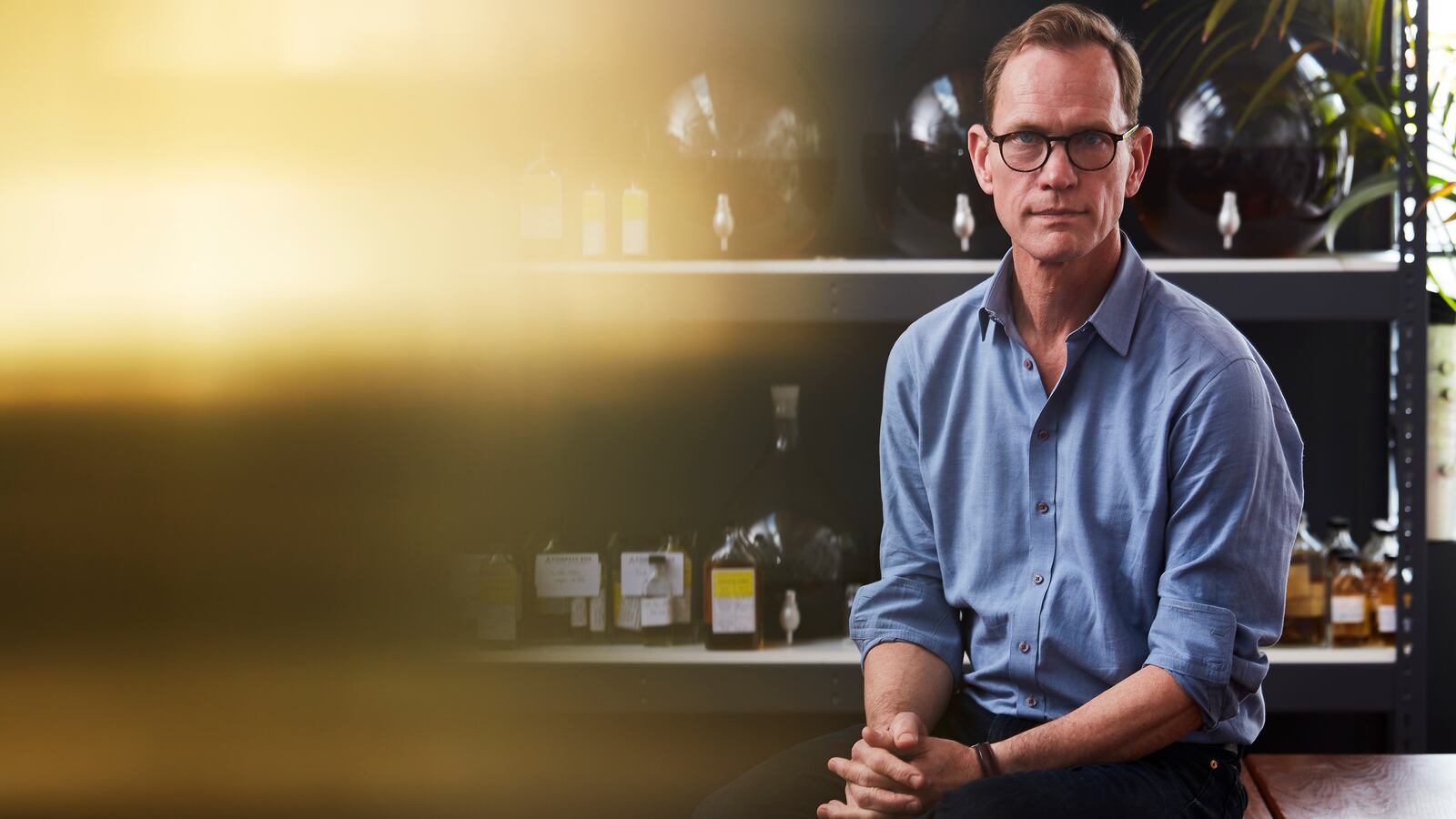I was hungry and John Glaser had a giant wheel of Parmigiano-Reggiano cheese.
It sounds like the start of a folk tale, but that’s how I first met the founder of boutique Scotch company Compass Box Whiskey.
It was nearly 20 years ago, at the annual event WhiskyFest. I was wandering around the ballroom of the Marriott Marquis Hotel in Times Square and Glaser was standing next to a wheel of cheese the size of a truck tire. “The wheel of cheese—I kind of forgot about that,” he recently told me with a laugh. “It did make us popular.”
If memory serves me correctly, he was wearing a new white t-shirt emblazoned with his company’s art nouveau–inspired gold logo. He didn’t look like a typical Scotch whisky ambassador who usually favors kilts or suits and ties. In fact, Glaser had the chic studious air of someone running a gallery specializing in impossibly expensive vintage mid-century modern furniture. What was he doing here pouring samples for thirsty whiskey geeks?
As I munched on a large piece of cheese that he had deftly chipped off for me, we chatted and I began tasting his whisky. He explained he was blending and bottling special barrels that he bought from Scottish distillers. Even in a room full of the world’s best whiskies, what he was pouring really stood out. At the time, the industry was just getting back on its feet after nearly three decades of declining sales and his plan was refreshingly innovative and optimistic. Remember, this was so long ago you could easily find Pappy Van Winkle and Blanton’s on store shelves for the suggested retail price, and when you asked for rye in most bars, you’d get a glass of Canadian Club.
When we met, the odds that some of the biggest brands would become popular again seemed very long, let alone an American upstart selling obscure whiskies. Glaser was either out of his mind or a true pioneer. I took his oversized card. Over the next few years, we chatted several times and I tasted more of his whisky, growing ever more impressed. By the time I wrote my first book, The Business of Spirits: How SavvyMarketers, Innovative Distillers, and Entrepreneurs Changed How We Drink, which came out in the fall of 2007, I included a short profile of Glaser about how he was disrupting the Scotch business. Even by then he had won a slew of awards for his innovations and inspired the bigger brands to follow his lead. (He had also had a public disagreement with the Scotch Whisky Association—the short story is that he lost and had to pull his whisky, which only helped his reputation.)

Compass Box’s success seems even more unlikely given Glaser’s career path. “I left university and got into the world of wine,” he recently told me. “I wanted to be a winemaker. I did retail, wholesale. I went to France for two vintages. I went to Napa for a summer.” He then got a business degree and started working for Scotch powerhouse Johnnie Walker, where he got a spirits education and saw the potential for making bespoke blends from unique whiskies. Two decades ago, the liquor companies were focusing on building just a few global brands and didn’t want barrels that didn’t fit their house style. “[My] desire to make stuff started to come back and I thought, I’m just going to start my own Scotch whisky company,” he said.
He was inspired by, “the kind of thing I’d been seeing in wine the previous ten years. That is, small businesses, entrepreneurs, people who get into it for the passion for making stuff and for the product.”
While he had seen these types of companies successfully produce wine and beer, it was still revolutionary in the spirits world. There were just a small number of craft distillers in America, and the craft distilling boom wouldn’t happen for nearly another decade.
He created Hedonism, his signature all-grain blended whisky, in his London home and had it bottled up in the Highlands. “I stayed up the night before in the Highlander Pub numbering the labels,” he remembers. On the morning of October 23, 2000, Glaser and his then pregnant wife Amy drove in their Volkswagen Jetta, loaded down with bottles, to Edinburgh’s Royal Mile Whiskies Shop to see if they could sell some of the first batch of Hedonism. (Amy got a craving, so they stopped at a McDonald’s along the way.) The store took two cases of his whisky, which turned his dream into an actual business. “I didn’t expect to sell two cases,” he said. “I was hoping to sell a couple bottles.”
To honor its 20 anniversary, Compass Box recently put out the limited-edition Hedonism Felicitas ($175), which is comprised of three grain whiskies. Glaser’s core portfolio also now includes the briny and smoky Peat Monster and the Great King Street Glasgow and Artists blends, which are a steal at just $40 per bottle.
One of Glaser’s skills is seeing value in things the rest of the industry has dismissed. For instance, to make a blended Scotch you take single malts from different distillers and mix it with what the Scots call grain whisky. This grain whisky can be made from a variety of grains and is produced on the more efficient column still as opposed to single malt, which is the production of a single distillery and is made entirely of malted barley distilled in a traditional copper pot still. While blends still makes up the bulk of Scotch sales by volume, single malts increase their market share every year. That means many blenders have started bottling or selling off the single malts aging in their warehouses without blending them. As a result, they are left with excess aged grain whisky. No one really talks about this grain whisky with all the buzz going to the single malt part of the blending equation.

Glaser realized that, contrary to popular belief, these grain whiskies could be delicious in their own right. It’s no surprise that grain whisky has become his most famous product, Hedonism. Its success has prompted other larger brands to introduce their own grain whiskies.
When we recently talked about the evolution of his business, I realized that his bottling of Hedonism fit into his larger business philosophy. He, in fact, subscribes to Ted Turner’s definition of an entrepreneur. “It’s not just, hey, I’m a gambler, it’s for whatever reason I am seeing stuff that other people aren’t seeing,” he said. Although, he admits that if whiskey drinkers and the industry hadn’t taken to his blends, “Don Quixote and windmills comes to mind.”
While Glaser still buys barrels of finished whisky from a range of distillers, his core business has started to change over the last eight years. He started to work with distilleries to produce whisky for Compass Box, including specifying the type of barrel the spirits are aged in. “Up till then, we were always buying everything mature and we still do buy most of what we’re bottling,” said Glaser. “But increasingly over time, what’s starting to happen is that stuff we laid down is going to make its way into our bottles. That to me is really exciting. And really understanding maturation better is really exciting. I still love what we do.”
Six years ago, Bacardi also became an investor in Compass Box. “Having them as a shareholder, has been really helpful in allowing us access to deep stock. That has been a huge benefit,” said Glaser.
Would he ever consider buying a distillery or building one? While Glaser confessed to having considered that option, he ultimately felt it wasn’t the right decision for the company. “I just like being a blender,” he said. “We have access to so much and there’s such breadth to Scotch whisky in terms of style from light and delicate to big and smoky.”
He still enjoys, as he puts it, “chasing deliciousness”—and wherever that may take him. “I feel like we’re only just getting going.”






